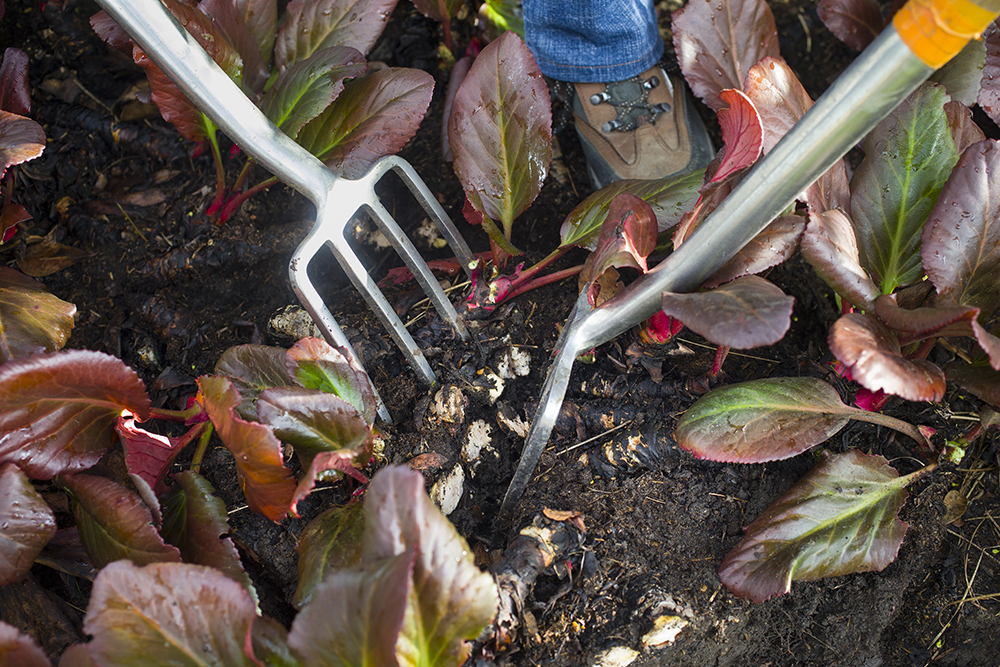September Easy-Gardening Tips
As the days get shorter and the sun lower in the sky, it’s time to gather in the harvest and prepare for the cold to come, as well as thinking ahead to the gardening cycle starting anew in the Spring
September is a truly rewarding month for the gardener that brings its own autumnal pleasure despite the fading heat and the nights that are drawing in. Who cannot take pleasure from the leaves beginning to turn a hundred shades of brown, yellow and red, or look forward to warm crumbles made from just ripe blackberries gathered from the hedgerows or apples fallen from our generous fruit trees? Indeed, you can always excuse that second helping as fuel for the jobs you’ll need to do this month that are explored below, along with our usual handy monthly tips that provide a fairly full list of tasks. Here’s to making the most of the September sunshine.
Dividing and conquering the perennials
Herbaceous perennials are plants lasting for more than a couple of years that have non-woody stems. They grow to their full height before summer flowering then die back, before repeating the process the following year. Favourites in the British garden include penstamons that are loved by bees as well as daylilies, hardy geraniums, agapanthus, asters, scabias and dahlias. There are literally hundreds to choose from in all different colours and shapes with many producing a second bloom if you remember to dead head them.
The commonality when dividing all herbaceous perennials is to ensure that it is done regularly and at least every couple of years to give you stronger, healthier plants, as well as providing the added bonus of more of them to plant elsewhere in the garden. Dividing can either be undertaken either in spring or early autumn and is best done with a fork, positioned underneath the centre of the plant before carefully lifting it out of the ground. Some smaller perennials can be divided gently by hand while others can be more easily split if you use two forks back to back as a lever, dividing across the crown and then sub-dividing as required. Ideally, a handful of healthy roots should be included in each clump and its best to replant them as soon as possible, obviously watering in well when you do so. If you have a moment, do watch this short film from crocus.co.uk which gives a practical demonstration on fork leverage.
Sowing hardy annual seeds for spring
Annuals are plants that go through their life cycle in one year. The hardy varieties which can cope with some frosty nights, such as candela, field poppies and cornflowers can be sewn in September while the ground is still warm and it will certainly be ‘job done’ for an exciting display of spring blooms. We particularly like the selection chosen by a supplier local to us, Chilterns Seeds which includes a delightful Calendula Officinalis ‘Pink Surprise’ marigold as well as the masses of violet clouds produced by the Consolida Regalis ‘Blue Cloud’, also known as Larkspur.
The great advantage of sowing hardy annual seeds in September is that the root system will have had time to develop before the plant starts to grow its summer flowers. This head start should also mean that the plants flower earlier and for longer. Wet and warm soil is key to success and temperatures that are hovering just below 20 degrees centigrade in the daytime will aid germination, so the earlier you can sow in September the better. If you think the soil is dry then give it a good watering the day before planting and try and choose a sunny day for sowing your seeds. You can also choose whether to ‘broadcast’ sow and scatter by hand which will give them a more natural look, or drill a shallow trough with a cane and plant the seeds in rows before gently raking over the soil and watering. In terms of positioning, nearly all hardy annuals prefer full sun and a well-drained soil if at all possible. Check out this short film featuring everyone’s favourite, Alan Titchmarsh who shows you how to sow a border of full of hardy annuals.
 Feeding your lawn for the coming winter
Feeding your lawn for the coming winter
As the growth of your grass slows for autumn, it is a good idea to raise the height of the blade on your mower and cut less frequently in order to gently ease the lawn into hibernation for winter. September is also an excellent month for feeding with some autumn organic lawn treatment from our Viano range which greens, thickens and strengthens the grass while killing moss and improving nutrient uptake in stressed conditions, including wear and tear from the summer. Also containing Viano’s unique organic ingredient called humifest which aids root development, the treatment is safe for children and pets and will cover a massive 200 square metres using a scarifier, while lasting up to 100 days. Remember next year’s lawn starts this autumn!
"By all these lovely tokens, September days are here. With Summer’s best of weather and Autumn’s best of cheer” said the poet Helen Hunt Jackson. September is certainly the best of both worlds with sunshine cool enough to work in all day, and just enough chill in the air to anticipate the full Autumn to come. We do hope you’ll be able to get outdoors and enjoy it and that you’ll also find some of the following gardening tasks rewarding as you prepare the garden for its seasonal rest.
TOP 10 TIPS FOR SEPTEMBER
![]() Dig up and divide herbaceous perennials using a fork to keep plants healthy and multiplied
Dig up and divide herbaceous perennials using a fork to keep plants healthy and multiplied
![]() Sow hardy annual seeds on warm days after rainfall by broadcasting them or by making a shallow trough for planting in rows
Sow hardy annual seeds on warm days after rainfall by broadcasting them or by making a shallow trough for planting in rows
![]() Collect seeds from annuals and perennials, dry in the sunshine and store in a dry, cool environment such as the garden shed, if not immediately re-sowing
Collect seeds from annuals and perennials, dry in the sunshine and store in a dry, cool environment such as the garden shed, if not immediately re-sowing
![]() Give your lawn an autumn feed as it begins to slow down its growth for winter
Give your lawn an autumn feed as it begins to slow down its growth for winter
![]() Adjust the mower to a higher setting for a gentler cut as the temperatures become colder
Adjust the mower to a higher setting for a gentler cut as the temperatures become colder
![]() Keep some colour in the garden with containers, pots or window boxes full of heather, cyclamen, winters pansies or heucheras
Keep some colour in the garden with containers, pots or window boxes full of heather, cyclamen, winters pansies or heucheras
![]() Plant spring bulbs such as daffodils, crocuses and hyacinths
Plant spring bulbs such as daffodils, crocuses and hyacinths
![]() Protect border plants by mulching before the frosts arrive with a layer that is about 8-10cm deep
Protect border plants by mulching before the frosts arrive with a layer that is about 8-10cm deep
![]() Give your roses a light autumn prune to reduce their height in windy winter weather, keeping the framework of them open by removing dead stems or cross stems that are dense, plus remove any leaves with black spot
Give your roses a light autumn prune to reduce their height in windy winter weather, keeping the framework of them open by removing dead stems or cross stems that are dense, plus remove any leaves with black spot
![]() Cover ponds with netting to protect them from leaf fall and save yourself a job next spring
Cover ponds with netting to protect them from leaf fall and save yourself a job next spring

Dizzy makes the most of the late September sunshine on Richmond Hill


